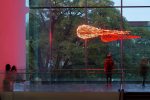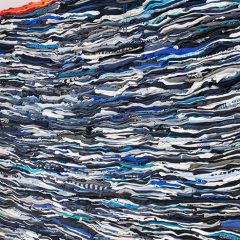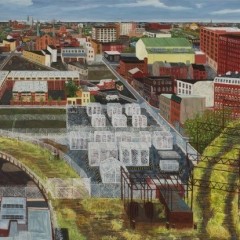[This week’s Weekly includes my story about Daniel Heyman’s trip to Amman Jordan to interview victims of torture in the Iraqi prisons and draw their pictures in order to spread the message. Here’s the link to the art pageand below is the copy with some additional pictures.]
The Art of War
A Philadelphia printmaker travels to Jordan to document torture.
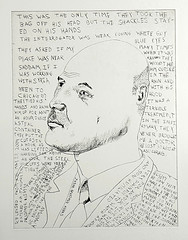
Jasim, the man who was killed two weeks after being interviewed by the lawyers, captured in a drypoint etching by Heyman.
Daniel Heyman took eight copper plates and a drypoint stylus with him on his seven-day trip to Amman, Jordan, last March. The Philadelphia artist and printmaker was traveling with journalist Tara McKelvey, several lawyers and a portrait photographer to witness the testimony of Abu Ghraib torture victims. The victims, who traveled at great peril from Iraq to Jordan, were giving testimony in a class action lawsuit on their behalf spearheaded by Philadelphia attorney Susan Burke and her team at Burke-Pyle LLC. Burke invited Heyman to come along as an artist to document the important story. Heyman wasn’t sure he’d get the printing plates back in this country, but he did.
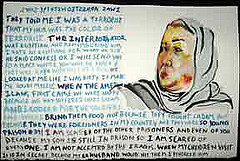
Watercolor drawing of a woman torture victim.
An award-winning artist and teacher, Heyman makes paintings and prints that are humanist and beautiful. A year ago, after the Abu Ghraib scandal made headlines, he started making works of a political nature based on photographs of the torture victims. The artist’s Amman works—delicate line drawings of individuals surrounded by a sea of words issued from their mouths—are beautiful and compassionate. The words form an almost decorative background for the figures, and are graphic descriptions of torture. It’s very hard to read them in the context of the victims’ faces captured with such sweetness by the artist.
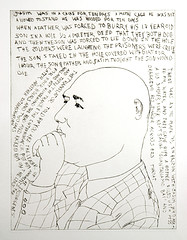
Another drypoint drawing of jasim
Transcribed during the one- or two-hour sessions and not touched again, the works have the freshness of an unedited tale told by a friend. There’s no fussiness—just reportage, including a few spelling and grammar mistakes, like you might have in a real conversation. Considering the artist was writing the translated stories backward, verbatim, as they were spoken, on a copper plate that—when printed on paper—would reverse the writing to make it legible, it’s remarkable there aren’t more mistakes.
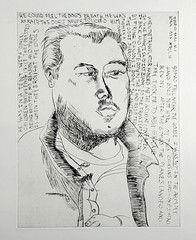
Another of the torture victims
Heyman’s on fire to tell these stories. He feels the responsibility directly, having spent hours with the victims, having dined with them in the same hotel at night (although without the translators, so they couldn’t communicate except by sign language). He felt their fear of retribution for participating in the lawsuit. One man wouldn’t let Heyman draw him because he was so fearful. Another, whom Heyman drew, was assassinated by an unknown gunman just weeks after the Amman interviews.
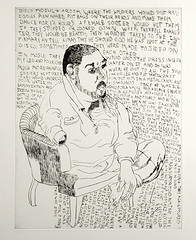
Man who lost an arm and a leg in a bombing.
The artist received a grant from the AMJ Foundation of Bob and Elizabeth Brand to publish the prints. The works will be on view this summer in Provincetown, Mass., and this fall at the Swarthmore College Library. Also this fall Heyman will produce a sculptural installation based on the work at the Crane Art Center during the Live Arts Festival. And he’s working on a limited-edition book.
Heyman’s on a mission few artists feel in their lives. He hopes to return to Amman. “Where are the artists making work about this war?” he asks. “Part of your job as an artist is to be a witness for your times.” He’s right. Our town’s Zoe Strauss is our witness to poverty in America. As for a war witness, Heyman’s on the job.


